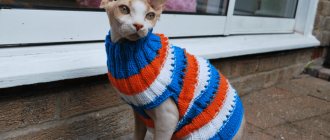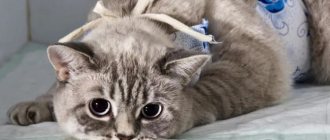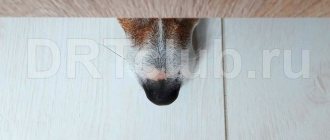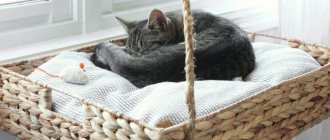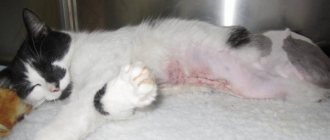After surgery (for example, after neutering or abdominal manipulation), a post-operative cat bandage or blanket may be needed.
Cats also wear it to protect the remaining sutures on the abdomen after surgical excision (surgery of the intestines, stomach). A postoperative bandage is a pressure cover placed on the animal’s torso, which covers the suture and wound in the abdominal cavity. Its use prevents the proliferation of microorganisms in the postoperative area. The bandage prevents the cat from licking stitches and wounds (healing and regeneration in the area closed to the tongue occurs faster). In addition, pathogenic microorganisms and bacteria do not enter this area.
Buy a blanket or collar in the online store =>>
Briefly about the purpose
We will not consider the options for the mentioned “clothing” only as an interesting addition to the image of a pet, although in some cases a blanket is really needed for practical purposes (for example, for heating short-haired or hairless cats and cats).
Most often, this element of a cat's wardrobe is used to protect the postoperative suture from dirt, pathogens, fungi, and even the tongue of the animal itself, which strives to lick the wound. Inflammation of the suture is one of the most important complications after surgery, so it’s not worth the risk.
Created on a fabric basis and placed on the cat immediately after the procedure, the bandage will block any access to the stitches and facilitate their quick tightening. In many private clinics, it is given to each operated animal at no additional cost, but even if this does not happen, you can purchase a blanket at any specialized store with a large assortment of similar products, or, as a last resort, sew it yourself.
Important! Before looking for a post-operative bandage or making one yourself, check with your veterinarian whether it is necessary to use it, because today there are many suturing technologies, after which a blanket is not required or may even cause harm. There are several types of blankets depending on their purpose - postoperative and protective (warm and waterproof)
There are several types of blankets depending on their purpose - postoperative and protective (warm and waterproof).
In the postoperative period, it is necessary to protect the sutures from licking - cats tend to lick their wounds and chew out surgical threads, which significantly complicates and prolongs the healing period. In addition, the intervention area should not be exposed to dirt and dust, and given that animals actively move around the house and are in the darkest corners, this can be difficult. A special postoperative blanket solves the described problems. It is worth acquiring if the following interventions have been carried out:
- castration of a cat (removal of the ovaries or ovaries along with the uterus in order to prevent further reproduction);
- surgery on the organs of the digestive system (stomach, intestines, etc.);
- surgeries on the urinary system (kidneys, bladder, etc.).
A postoperative blanket for a cat allows you to protect the wound after abdominal surgery from licking and dirt.
Terms of use
The animal's sutures must be periodically washed and treated during the postoperative period. In the process of performing such actions, the blanket does not need to be completely removed. Only the bottom pair of ribbons is untied. The product must adhere firmly to the cat.
If the bandage is dirty or has strong discharge, it is removed and replaced with a new one. Blankets should be changed regularly to minimize the risk of rotting and wound infection.
The product is completely removed only at the discretion of the veterinarian. If the blanket was made correctly and used correctly, it will ensure a quick recovery for the cat.
How to tie?
First make sure that you have positioned the blanket correctly. The guide is the symmetrical cutouts for the front paws. The animal's head should be located slightly in front of them, and the cutouts themselves will be located in the area of the animal's front armpits.
A simple classic blanket has 14 laces for fastening, symmetrically located along its side edges. They will need to be tied on the cat's back. Considering that you will have to remove the bandage periodically, you should not make the knots too tight. But it is dangerous to tie the laces too loosely: the animal can untie them with its teeth and subsequently get rid of the bandage.
- You need to tie the blanket on the cat from the head. Take the two very first laces from the front and connect them at the animal's neck.
- The next two pairs of ribbons must be tied crosswise in the area of the cat's shoulder blades, that is, the left tie from the second pair is connected to the right tie from the third pair, the right ribbon from the second pair is connected to the ribbon from the third pair of ties, located on the right side. This way you should get a crosshair made of laces, which will be located above the withers.
- The following ribbons are tied in pairs on the back.
- The last two pairs of ties are fixed crosswise on the back of the cat's body.
It is important to ensure that the postoperative bandage does not cover the animal’s excretory openings: the anus and urinary tract. Otherwise, due to inconvenience, the pet will actively try to remove the blanket
And you will have to face the fact that the bandage will soon be dirty.
The bandage should not squeeze the cat's body tightly. If you notice that the animal is moving stiffly, loosen the lacing.
It is best to have a second blanket in reserve.
If the surgical suture is small, then to treat it it is not necessary to remove the entire bandage - free only the part of the body where the wound is located. This way you will save time and effort in the process of tying and fixing the bandage.
Do not leave long ends of laces. A cat can easily pull them with his teeth, loosen them, or untie the knot.
It is allowed to remove the blanket for 15–20 minutes 2–3 times a day, especially if the animal does not get used to it well. But the cat should be under your strict supervision at this time. When trying to lick wounds and stitches, you should immediately gently prevent this: distract the animal with play or pet it.
To learn how to put a blanket on a cat and tie it correctly, watch the following video.
Purchasing a finished product
If the owner bought a ready-made postoperative apron, then the product packaging contains instructions on how to tie it correctly. When making a protective bandage with your own hands, it is sewn from a fabric base and 7 pairs of ribbons.
The first pair is tied around the pet’s neck, the second and third are tied crosswise among themselves (the front legs will be at this level), the fourth and fifth are fixed on the back, and the sixth and seventh are also crossed crosswise at the level of the hind limbs.
The bandage must be tightened sufficiently so that the pet’s movements are as free as possible. However, if it is tied too loosely, a resourceful animal will easily pull it off. No wool should get into the knots of the ribbons.
The back of the bandage should ensure free flow of urine and feces, otherwise it is better to cut off the excess fabric.
The veterinarian may, if necessary, prescribe treatment of sutures after surgery by applying bandages with healing ointments. Without removing the blanket, it is enough to untie only the last two pairs of tapes for processing, which simplifies seam care.
Many pets experience severe discomfort when they feel any foreign object on their body.
What can we say about an object that covers almost the entire body, hinders movement and cannot be removed. However, you should not immediately give in to your pet’s demands to remove the hated blanket; after a few days, the animal will get used to it and stop trying to tear off the bandage.
Kinds
Do not think that a blanket is the only type of medical bandage. In fact, there are several varieties of it. Different types of blankets differ in their features and design. Let's get to know them better.
Warm
Cats, which are representatives of hairless breeds, often freeze when there are cold seasons outside the window. This not only causes significant discomfort for pets, but can also lead to the development of colds. In such circumstances, a special warm blanket would be an excellent solution. Most often, caring owners of Sphynxes and Cornish Rexes turn to such things. These types of blankets look like simple sleeveless vests.
The best and most comfortable blankets are warm blankets made from soft fabric with large pile. Such things effectively protect hairless or short-haired cats from low temperatures and cold gusts of wind. Even during a walk, your pet will be warm and comfortable in a cozy blanket.
Separately, it is worth highlighting the knitted woolen blankets that fit the body well. These specimens are especially warm and have an excellent warming effect. They are very comfortable for cats and kittens.
Homemade
Among cats and kittens, there are a lot of individuals that suffer from allergic shedding. In this case, the owners constantly have to vacuum the furniture in the house, but this is only a temporary measure - soon all surfaces are again covered with hairs that have fallen from the pet’s body.
In such situations, many people look at hairless cats, mistakenly believing that the lack of hair makes them completely problem-free. Such individuals have another common ailment - profuse sweating. Because of this, stains may remain on upholstered furniture, which can be very difficult to remove completely.
In the above situations, homemade blankets can be a real salvation. These products easily and simply absorb secretions from the body of hairless cats. Wool loss with such blankets is also noticeably limited. This is why homemade products are so popular and in demand today. However, most home models of blankets still fall into the category of interesting animal wardrobe items.
Raincoats
When walking with an animal outside in cloudy weather, it is worth keeping a small raincoat for your pet. Such models, as a rule, have a hood and are fastened under the neck and belly of the cat. Raincoats are made from special water-repellent fabrics, such as nylon or vinyl chloride. Polyamide fiber of rich colors is in no way inferior to transparent film in its properties and characteristics. If a rainstorm suddenly starts, the animal in such a cape will only wet its paws.
Postoperative
Initially, after various operations, cats were given a special Elizabethan collar. It was a large cone that was fixed on the animal’s neck and did not allow it to reach the wound. Of course, such things were very disturbing for the pets and caused unnecessary stress. In addition, pets wearing such collars could not wash their faces properly, and eating in them was problematic - the edges constantly hit the bowl, and the food did not always get into the animal’s mouth. Moving around the house in such a collar was also problematic, it threatened injury: the cat could get caught on furniture, doors or doorframes.
It is not surprising that the blanket has become a wonderful replacement for this outdated device. In such a thing with a zipper or Velcro, the pet can move freely around the house, eat normally, and even play. Although protective mantles may slightly restrict the movements of cats and cats, they still will not prevent pets from leading a normal lifestyle. Thanks to this, the recovery process is much easier and faster.
Choosing a sanitary dressing
Veterinary clinics and pet stores have a good selection of these devices, but they all have a range of sizes. To make the right choice, you need to know the measurements of the animal.
You need to take care of protective equipment for your pet in advance, even before the scheduled operation. Then your pet will quickly get used to the medical gown, and wearing it after sterilization will not aggravate the stressful condition. Prepare at least two hygiene items to replace them after contamination.
When purchasing a product, pay attention to its appearance and fabric composition.
Material
Medical blankets in pharmacies at veterinary hospitals are usually made of non-woven fabric. This base does not contain lint and does not crumble if you need to trim the product to make it more comfortable for the animal. The pressed fibers perfectly absorb liquid, keeping the surface of the wound dry. Another advantage of such a base is its resistance to tearing by claws, as well as a long service life. The product can withstand repeated washing and does not affect your pet's skin.
Factory blankets are sewn from different fabrics:
- cotton;
- viscose;
- spunbond;
- meltblown.
To ensure free access of air to the wound, material made from natural threads is preferable. Foreign manufacturers often use a cotton-lycra blend to give the product stretch. In this case, the fabric limits freedom of movement less.
Size
Factories usually sew post-operative blankets for adult cats weighing 3–5 kg. Finding a protective device for a kitten is more difficult. For him, the size of the product along the length of the body from the base of the neck to the beginning of the tail will be 28 cm, and the model range starts from 38 cm with a chest circumference of 31 cm. Large animals with a body weight of 6–10 kg will be suitable for a protective bandage with dimensions of 42x35 cm.
Model type
There are several types of medical blankets for cats. They differ in the processing of the holes for the paws and the way the bandage is secured to the animal. A one-piece product with slits is less common than a coverlet that covers the limbs. The sleeveless robe is trimmed with a durable piping that covers all the edges and prevents the fabric from fraying.
A blanket with cutouts for cat paws is used in the treatment of back wounds
Most post-surgical blankets are secured to the pet's back with 6-7 pairs of ribbons. Bandages with Velcro fastening are much easier to use. The wide apron can be easily removed if necessary. On an individual order, the tailor can improve the fastening by replacing part of the ties with a zipper braid.
There are also expensive models with push-button clasps on sale. They are located on both sides near the animal's neck. Dutch manufacturers have equipped the hygiene product with an internal pocket. A bandage with medicine is placed there.
General information
It’s difficult to say when the postoperative bandage was invented. Previously, a cat's actions were limited by a cone - an Elizabethan collar, which was not always convenient in terms of eating and drinking, moving around the room, and washing its face. A blanket or bandage is much more comfortable, and the animal’s recovery occurs much faster.
A patent for a postoperative bandage for cats was received by the Kovalev family in 2002. Their bandage was a cover with Velcro along the spine and on the neck instead of ties.
On a production scale, medical bandages are made from viscose, cotton, meltblown or spunbond. For skin ventilation, the ability of the material to allow air to pass through is important; the fabric must have a natural composition. Some foreign companies produce blankets made of material with lycra. This fabric stretches better and provides the animal with freedom of movement.
You can purchase a bandage on the Internet and in a regular pet supply store. You can buy it at a price of 79 rubles. Before purchasing a pet, the chest girth is measured and weighed. A correctly selected bandage leaves part of the pet's body exposed, not exceeding 8-9 cm. The volume of the blanket will be adjusted with ties. The factory product is designed for cats weighing at least 3 kg and up to 5 kg; it will be difficult to find a similar thing for a small kitten.
If for some reason it is not possible to purchase a belly bandage, below is a story on how to sew a blanket with your own hands.
When to remove the blanket from a cat after sterilization, how to care for the cat?
After sterilization, there is a seam on the cat’s stomach that needs to be properly treated so that pathogenic flora does not get on the wound, and she herself does not lick the seams; for this, a blanket is put on her; it protects against unwanted interventions from the outside and promotes healing.
You can sterilize a cat using several methods, according to the classical scheme, which is well established, when the belly is cut along the white line; the speed of wound healing depends on when to remove the blanket from the cat after sterilization. If the cat is well cared for, the suture closes quickly, such an intervention causes virtually no complications, and usually the owner knows when to remove the cat’s blanket after sterilization. They can also sterilize through a side incision; this is a less traumatic method compared to the first one, since the muscles are not cut with a scalpel, but are moved apart, and healing is faster. There is another scheme, but today it is rather exotic, this is laparoscopy, it is minimally invasive, practically does not injure the cat, but due to its high cost it is almost never used.
A cat can undergo an ovariohysterectomy, which involves complete removal of all organs responsible for reproductive function, or an oophorectomy, where only the ovaries are removed. But complete removal is preferable, since the uterus left in the abdominal cavity can become inflamed over the years, the operation will have to be performed again, but the old animal may no longer withstand anesthesia. Postoperative care depends entirely on the type of surgery, but in any case, the integrity of the tissues has been compromised, so there will always be general malaise. In the postoperative period, the animal must be provided with complete rest; children or other pets must not be allowed near it; the sutures must be regularly treated
They are applied to the skin, the inner wall of the abdomen, so it is important that the cat moves less, otherwise the stitches may come apart or internal bleeding will begin.
Sutures can be applied to the skin in two ways, as a rule, this is done using a non-absorbable thread, which will have to be removed after a week or 10 days, and an absorbable thread, such a thread will dissolve and fall off on its own, nothing needs to be removed.
After applying sutures, the veterinarian can “preserve” them by treating them with “Aluminum Spray”, in this case no care is required, aseptic treatment 100% protects the wound, dirt and bacteria will not get into it. If this has not been done, you will have to put a blanket on your pet to protect the seam from bacterial contamination. This accessory is easy to put on and can be secured with ties. Typically, cats do not experience pain, except in the first two days after the intervention, and then it is not intense, so there is no need to administer painkillers. If the cat meows, does not touch food, and cannot lie on its stomach 3-4 days after the operation, bleeding into the abdominal cavity should be suspected. This can happen due to improperly sutured internal tissues, poor coagulation of blood vessels in the uterus, and its stump begins to bleed; repeated surgery is required to remove blood clots and fibrin adhesions from the abdominal cavity.
If dirt gets in, the seam can become inflamed and fester. To prevent this, the cat needs a blanket, it is put on immediately after the operation, and it must be kept clean during this period; under no circumstances should it be allowed to go outside. If the wound does become infected, it is necessary to take the cat to the veterinary clinic, since the stitches in this condition do not heal, they will have to be removed, then, under anesthesia, clean and remove the areas of tissue affected by necrosis and stitch the stitches again. If a lump is suddenly discovered in the area of the suture, then this is considered normal, the tissues are healing, granulation tissue may grow, but in about a month it will resolve.
In some cases, when the owner cannot care for the cat on his own due to being very busy, he can go to a clinic where they can take him in for foster care until he recovers; in addition, some of them provide services for transporting animals to surgery and back home.
When a cat goes on a spree, it is not very pleasant for both itself and its owners; few people like constant uterine meowing, refusal to eat and the desire to leave the apartment, so the most humane way out of this situation is sterilization.
Why is it needed?
A blanket for a cat after sterilization or any other manipulation is necessary in order to protect the scar after surgery from dirt and licking. This bandage is required, as cats instinctively strive to heal their wound on their own.
If you do not close the scar in any way, then the animal may try to such an extent that the threads break and the seam comes apart.
The blanket also protects the cat from ingesting medications that are applied to treat the suture so that it heals as quickly as possible. The bandage will protect the animal from licking substances that, if ingested, can be very harmful.
Short-haired animals can be cold in winter. Canadian Sphynx cats sometimes need to buy indoor clothes so that they do not freeze and do not dirty furniture, since this breed is characterized by sweating due to its accelerated metabolism. In this case, the bandage is a means of hygiene.
In addition to homemade blankets, there are rain blankets. They are essential for those who walk cats or whose cats like to go outside. Protects against wind, dirt sticking and subsequent licking. After all, cats are clean creatures.
How to sew it yourself?
Before you start making new clothes for your pet, check with your veterinarian whether your cat needs a blanket: there are many techniques for suturing and post-operative care, and sometimes a blanket is not only unnecessary, but can also harm the cat. Sterilization also has a huge number of possible options today.
If you still need a blanket, then you still shouldn’t rush to sew it. As a rule, it is very inexpensive and any decent veterinary clinic includes it in the cost of the operation. But if such a need arises, use these instructions:
Take the necessary measurements - chest volume, body length, distance between paws and paw circumference. Based on the presented pattern, create on any paper a similar drawing with the parameters of your pet. Then place the pattern on the fabric and do not forget to allow seam allowance for the edges. The bandage can be either single-layer or multi-layer, it doesn’t matter. But you should approach the choice of fabric more carefully: give preference to dense fabrics that are not prone to crumbling and can withstand the onslaught of cat claws, because your cat will probably touch it with its paws more than once. It is equally important that the fabric is breathable. At the last stage of creating the bandage, sew the ties
It is very important that the ribbons are durable and able to withstand all the cat's manipulations, but they should not be too tight.
We make it from improvised materials
To create a bandage yourself, you often use stockings or long sleeves from T-shirts: it is very convenient to give them the necessary head start, and their fabric is suitable in all respects - it tightly covers the wound and allows air to pass through.
To create a stocking or long sleeve bandage, you will need scissors and a stocking.
Instructions for creating a bandage:
- Based on the size of the cat, we cut off the stocking or sleeve. Next, if you are using a stocking, you should cut off its toe - this will be the hole for the head.
- Now we create holes for the hind and front legs.
Important!
Putting on such a bandage correctly is very simple: stretch the stocking with both hands and gently pull it over the cat’s neck
Then carefully guide all the tabs into the holes. All is ready!
Store-bought or homemade?
Experts recommend giving preference to purchased blankets: as a rule, the product is made of non-woven medical material, thoroughly disinfected and has an anatomically correct design. In this case, the process of changing the bandage is also significantly simplified, because many modern blankets are equipped with Velcro. If you want to find a use for your creativity, see how you can sew a soft house with your own hands.
However, a hand-made product also has its advantages:
- By creating a pattern yourself, you can sew a blanket that is perfect for your cat.
- Using a successfully saved pattern, you can, on occasion, sew as many bandages as you like.
- if the bandage is made from your clothes, the pet will wear it much more willingly, because it will smell like its beloved owner.
There are several options for blankets:
- Warm. If your cat comes from a country with a warmer climate, you need to take care of winter insulation and purchase a blanket with insulation.
- Homemade. Owners of Sphynx cats know firsthand what cat sweat stains on furniture are, even if the cat takes a bath once a week. Experienced owners of this breed have one secret that can make life easier for both the cat and the owner: homemade blankets in the form of “robes” made of light fabric. They will not only protect the furniture from stains, but will also allow the skin to breathe, which is so necessary in the postoperative period.
- Raincoats. Bad weather is not a reason to stay home! Strengthen your immune system with walks in the rain, but don’t forget about special clothing for your cat, because animals also get colds. A raincoat will protect not only from moisture, but also protect from dirt, and therefore from unwanted germs getting into the wound.
Features of care with a bandage
Sometimes it is necessary to treat the seam with special solutions and apply a bandage to it, but for this you do not always need to remove the blanket completely.
Sometimes all you need to do is untie a couple of tapes to gain access to the wound. If you remove the bandage completely each time, you will only cause unnecessary stress to your cat and slow down the healing process.
Important!
Make sure that the tightness of the ribbons is always in the same condition - not too loose and not too tight.
In the first case, the cat may scratch the wound or begin to lick it and lick off all the medications, which will negatively affect its body. In the second, you can provoke a lack of air or provoke friction of the seam against the fabric, which will lead to the wound festering.
Sometimes cats recover very quickly after sterilization and begin to lead an active lifestyle. Strictly ensure that the cat's activity during this period is limited - during excessive activity, the seams may come undone, or the blanket may get caught on the protruding corners of the furniture while jumping.
Reference!
When helping a cat relieve itself, you do not need to remove the blanket completely. All you have to do is untie the back.
How to wear a blanket correctly?
The effect of its action depends on how you put the blanket on your pet, so it is very important to do it correctly. It is recommended to do this together (as well as trimming claws, by the way) - one person puts on the blanket, the other calms the cat and does not allow it to escape. The sequence of actions should be as follows:
- Place the product on the table and carefully straighten all the ties.
- Next, you need to carefully lay the cat on the product and hold the pet a little. To make the animal a little distracted and less nervous, talk to it, stroke it, but hold it in such a way that there is no interference with tying the blanket and strong pressure on the cat, it is already in pain.
- Having laid the cat down, first fix the ribbons in the head and front paws. Tie the back ropes, then the ribbons in the waist area, if your bandage requires them.
When can I shoot?
When can you remove the blanket after sterilization? Here you should follow the recommendations of your veterinarian.
Important!
It is usually recommended to remove it after 10-15 days; the wound usually does not heal faster.
Instructions for putting on
Most often, the blanket is secured to the animal’s body using regular ties. Velcro versions are available for sale. Dressing a cat in such a bandage is much easier, but blankets with Velcro are more expensive.
The first putting on of the blanket occurs immediately after the operation. Most often at this time the animal is still under anesthesia or only partially conscious. In this state, the cat does not offer resistance, which greatly simplifies the process. You should be very careful and careful, do not make sudden movements when manipulating the animal’s body: fresh seams can be damaged very easily.
In the future, you will have to repeatedly treat the wounds and put a bandage on an already active animal.
It is important to act as calmly as possible. If a cat is nervous and resists, talk kindly to your pet and pet him
Spread the bandage on the table and place the cat on top of it, tummy down.
It will be better if someone helps you the first time - it is much easier to carry out this process together.
Observation after removal of the bandage
After the bandage is removed, it is necessary to carefully monitor the cat's condition in the first days. The cat family is characterized by increased cleanliness, therefore, at first the animal will constantly lick the seam.
The owner must ensure that the cat does not chew the edges of the healed wound.
Be sure to read:
Complications after castration of a cat: causes, types, symptoms and treatment, when you need to see a doctor
Important points during inspection:
- monitor the integrity of the edges of the wound surface;
- control whether there is any discharge from the wound in the form of blood or lymph;
- inspect the seam for redness, inflammation, and the appearance of purulent discharge;
- check whether nodes or swellings have appeared along the edges of the wound surface.
Any of the identified anomalies is a reason for an unscheduled visit to the veterinarian.
How to properly put a blanket on a cat
It is better to tie a blanket while the animal is still under anesthesia. Adjust the length of the ties so that the loose ends do not interfere with the animal.
It is better to immediately cut off the excess so that the cat cannot accidentally get caught on something and injure itself during the owner’s absence. Observe how the cat behaves. If wearing a blanket for the first time causes stress, remove the product from it and try putting it on again after a while. Don't expect a pet in a bandage to behave the same way as usual, because these freedom-loving animals do not like to have something put on them.
Making a DIY bandage for cats is not that difficult. But you need to follow all the rules of work and wear it correctly.
The subsequent effectiveness for your cat depends on the cut of the blanket. It also needs to be tied correctly. If the ties are too tight, then the stitches and wounds after sterilization in cats will take a long time and heal poorly. And if they are too loose, the seams will rub when moving, or the cat will try to take it off.
You need to put a blanket on a cat like this:
- lay out the product and straighten the ties on it;
- carefully place the cat on top and secure the ties in front in the area of the head and forelimbs;
- We tie the back ties in pairs and tie them in the cat’s pelvic area.
The sequence of actions may differ slightly from the one given, it all depends on the cut of the bandage. Be sure to ensure that the blanket is properly secured. Let the cat walk around the room, if it is calm and does not try to remove it, then everything has been done correctly.
Most often, animals do not really like such clothing. They constantly chew and tear the bandage, trying to get rid of it. That is why you need to carefully select the fabric if you sew it yourself, so that it is durable and pleasant to the touch.
In order for the blanket to perform its function, it must be worn correctly. When putting on a bandage, it is forbidden to tighten it too much with ties. It is also prohibited to let it dangle from the pet. The product should not hinder the movement of the animal. The blanket is worn with a tight fit to the body.
A homemade bandage, if made correctly, will allow your pet to endure the postoperative recovery period well and return to a full life.
If the animal is under anesthesia, then putting a bandage on it will be quite simple. Another situation is when the cat resists. Then doing it alone is not recommended. It's better to ask someone at home to help.
Caution: Do not squeeze the cat too hard, as this may cause the seam to come apart. If you need to put a blanket on a cat that has already recovered from anesthesia, act not with coercion, but with affection
Those who are going to put a bandage on a pet for the first time and feel unsure should practice on inanimate objects, for example, toys, and only then approach the cat.
Sometimes the cat strongly resists and does not allow the blanket to be put on itself. After some time, you can repeat the attempts, because over time the animal gets used to this procedure. As well as, for example, rubbing the eyes.
Step-by-step instruction:
- First you need to tie the laces closest to your neck. Grab your head, but gently.
- Now tie the ones between the neck and front legs.
- Tie each pair of laces towards the tail.
- The last two ribbons must be tied crosswise around the cat's rump.
And do not forget to leave the anus and urethra open. Otherwise, the pet will not be able to go to the toilet normally and will worry or stain the bandage. Make sure that the blanket not only does not cover, but is not too close to the urethra and does not become wet from the animal’s urine.
Sometimes it happens that a cat, after putting a bandage on it, cannot move calmly. Then it is worth loosening the tapes so that the animal does not suffer, because he already needs to recover from the operation.
You should put on the blanket as carefully as possible: after the operation, when the stitches are healing, any careless movement can cause pain to your pet. Tying a post-operative blanket is an art
But after studying the diagram below, you can easily figure out what’s what.
Blanket fastening diagram
We tie the sixth and seventh pair on the outside of the thighs. Already tied, we connect the ends of ties 6 and 7 above the base of the tail.
Choosing a product in the store
When choosing a product in a store, you need to know the size of your pet. The packaging should not be opened for hygiene reasons. If the seller offers opened packaging, refuse such a product. There are three sizes: small (S), medium (M) and large (L). The main measurements are the distance from the base of the tail to the base of the neck and chest circumference.
The blanket should fit snugly to the body, but at the same time make the animal comfortable. The fasteners can be ties or Velcro. In the case of Velcro, this is convenient when the cat is short-haired and the hair will not get on it.
The advantage of ties is the ability to slightly increase the size, for example, if the animal has gained a little weight.
When purchasing, it is better to choose a lighter color of the fabric. This way you can easily determine when it’s time to change the bandage.
We recommend purchasing a replacement version immediately. When choosing, carefully inspect the stitching of the product: there should be no protruding threads. Even the smallest thread, if caught in a seam, can cause fester. The ties are wide and firmly stitched. The kit should include instructions on how to properly tie a blanket on a cat.
In case of non-standard body proportions or in order to save money, you can easily sew a blanket for a cat with your own hands.
What to replace it with?
If a person is not good at sewing, then for such work he will need children's clothing in the form of a bodysuit. You can make a blanket from scrap materials. If the animal is small, a belt made from a sock will do.
It is important to remember that the sock must be completely new and never used. Slots are made in the designated places through which the paw can be inserted
However, such a blanket is unreliable because it can be easily removed. For an adult cat, a blanket made from tights is suitable. It is important that the product has increased density. In addition to tights, you can use a pant leg or sleeve cut off from unnecessary clothing. As in the version with a sock, holes for the limbs are cut in the required places. A good option that replaces the cat wrap is a baby bodysuit.
We sew a blanket for a cat with our own hands
Despite all the advantages of homemade blankets from improvised means, they also have quite significant disadvantages. In particular, it can be difficult to choose an individual size, and not everything is good with the materials.
The only way out (unless, of course, the owner wants to buy a ready-made option) is to sew the blanket yourself. This is not difficult to do, even if you don’t have much sewing experience.
Taking measurements for a pattern
To know what size the blanket should be, you must first take all the necessary measurements (using a measuring tape, of course).
The pattern is drawn based on the following data:
- Chest volume.
- Body length (body only, no need to measure tail).
- In addition, you need to take a measurement of the distance between the paws (between the front and between the hind).
Some breeders also advise measuring the coverage of the limbs themselves, but this, in our opinion, is unnecessary. The fact is that this information is needed to accurately calculate the length of the ribbons, but it can be determined by eye.
Below we give an approximate view of the pattern. Using the measurements of your pet, you need to transfer it to measuring paper. The diagram below clearly shows where exactly the ribbons that serve to secure the blanket to the animal’s body need to be sewn. If the owner is comfortable with a needle and thread, he can make a blanket with Velcro. They are much more convenient.
There is no special need for “cross stitching”. If the cat owner does not know how to sew at all, no one forbids simply transferring the contours of the pattern onto the fabric and then cutting out the finished product. Of course, the strength and convenience of such a blanket will be lower, but the finished product will perform its functions in full.
Choosing fabric for blankets
The material for the bandage must meet the following requirements:
- You need to choose a fabric that is soft and elastic enough, but at the same time not prone to strong stretching.
- Under no circumstances should the material crumble, contaminating the postoperative wound with fibers and other debris. To test this characteristic, you need to take a small piece of material and tie it tightly. Good fabric will not tear and pieces of thread will not fly off.
- In addition, we strongly advise against choosing dyed fabrics, since, despite all the assurances of the manufacturers, they can fade.
Velcro or ribbons: which is better?
A separate section should describe the process of choosing between Velcro and regular ribbons. Each owner is free to decide for himself which option is more suitable for his pet, since there is no consensus on this.
We will simply describe the positive and negative aspects of each type of fastener.
Pros of ribbons
- They can be made from the same fabric, no need to buy anything extra.
- Easier to sew.
- The ties are unlikely to unravel spontaneously.
Cons of ribbons
- The cat can cling to surrounding objects with them.
- If the knot is too tight, it may be difficult to untie the ribbon.
Pros of Velcro
- They are very comfortable. “Sticky” fasteners greatly simplify the process of putting on and taking off the blanket.
- Such fasteners are very compact, the cat is guaranteed not to get caught on anything.
Disadvantages of Velcro
- Additional financial expenses will be required.
- Velcro quickly becomes dirty and loses its quality.
- The cat can quickly learn how to unfasten them.
how to pick up a cat after sterilization
Why sterilize your cat?
In all civilized countries, sterilization is a routine procedure. In the USA, Germany, Canada, Great Britain and a number of other countries, an additional tax has been introduced on the maintenance of non-sterile cats and dogs. A person, having decided to have a pet, does not even ask himself whether to sterilize the cat or allow it to breed. Breeding is done by professionals. Breeders sterilize kittens that will not participate in breeding and adult pets that are retiring. This is a valuable experience that needs to be learned. Compare the situation with homeless animals in our country and in theirs. In Europe, Great Britain and the USA, cats and dogs are treated with great love! You can bring pets almost everywhere; there are places where you cannot go with a child, but you are welcome with a dog or cat. Sterilization is not cruelty or barbarism. This is a humane procedure that makes pets and their owners happier.
Nature (God, higher intelligence) created all life on Earth. If a cat is given the opportunity to be a mother, she should become pregnant and give birth, this is natural. You can't argue with that. But it is natural for a cat to live on the street, eat mice and birds, suffer from flea bites, infectious diseases, cold and heat, and die at the age of 5-7 years! A person who takes an animal into his home does not agree with this. We want our four-legged friends to have good health and live as long as possible. Why then do we, with our own hands, harm our pets? Any human doctor, any veterinary student will tell you that childbirth is always stressful and a huge burden, plus known risks. Pregnancy and childbirth, even if they occur absolutely normally, shorten a cat’s life expectancy. For what? Play with kittens, not interfere with the natural course of things, save a certain amount? Steril
Source
Sewing blankets from improvised materials
Below we will describe how and from what you can make a blanket if you don’t have any suitable material or patterns at hand. You don't need any special cutting and sewing skills.
Scheme of overalls for a cat
Pantyhose blanket
The simplest option, which requires virtually no resources. There is only one rule: you need to use clean tights, since the animal definitely needs sterility after surgery and sterilization. It is recommended to use thick tights that will fit the cat's body well.
Important! The blanket is made like this: a piece of trouser leg 20 cm long is cut off and pulled over the cat’s belly. Additionally, you can make holes for the paws
New Year's suit for the British
Sock blankets without ties
The product is made from socks or stockings in the same way. Find the perfect size sock and cut off the front to create a fabric tube. The cat's body is inserted into it, fixing its stomach.
For your information! The most remarkable thing is that even if you don’t have the appropriate sizes at home, you can always buy clean and new socks at any clothing store for a few tens of rubles.
Cat blanket from a baby bodysuit
Blanket from old children's clothes
Old children's clothing in the form of jumpsuits and vests also works well. You should choose something that fits comfortably on your body and is fixed on it. If you don’t have anything like this at hand, then you can make a blanket from an ordinary sleeve of a children’s jacket that stretches well.
Fashionable outfit with a hood
Towel blankets
The most common option involves making it from a simple cotton towel. A cut of the required length is made, and holes for the paws are cut out, based on the anatomical features of the cat. Holes are cut in it for the neck, paws and sometimes the tail. The final stage involves creating a cylinder by sewing the ends of the towel together or sewing on strings.
If the cat is to be sterilized, then you need to buy a blanket
Dress for the sphinx
Using a simple pattern, you can make a beautiful dress for your hairless Sphynx cat. The most remarkable thing is that a dress of this kind can be made from just two pieces. First of all, the main part is made, and then the sundress, which is sewn to the base.
For your information! All this takes very little time, but looks very attractive. Do-it-yourself clothes for the sphinx, the patterns of which are presented in the picture below, can be made in a matter of hours.
Knitted suit on a Canadian cat

